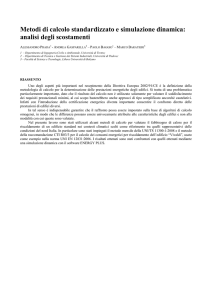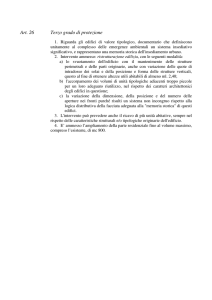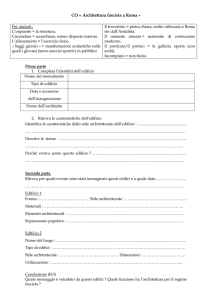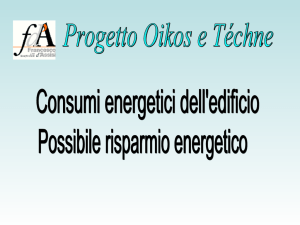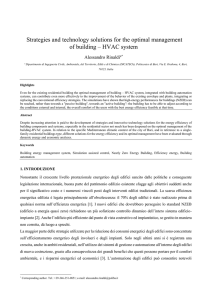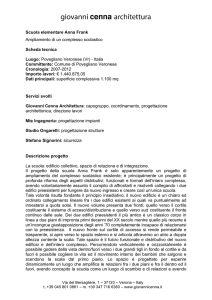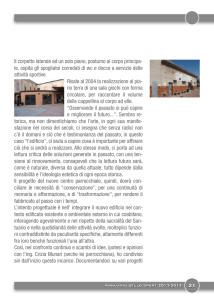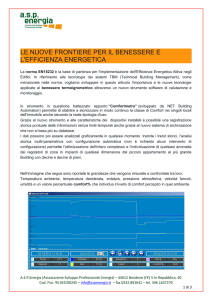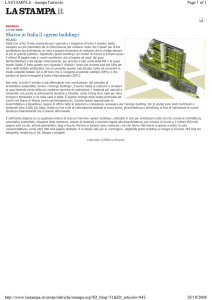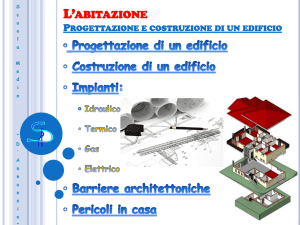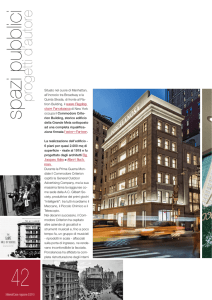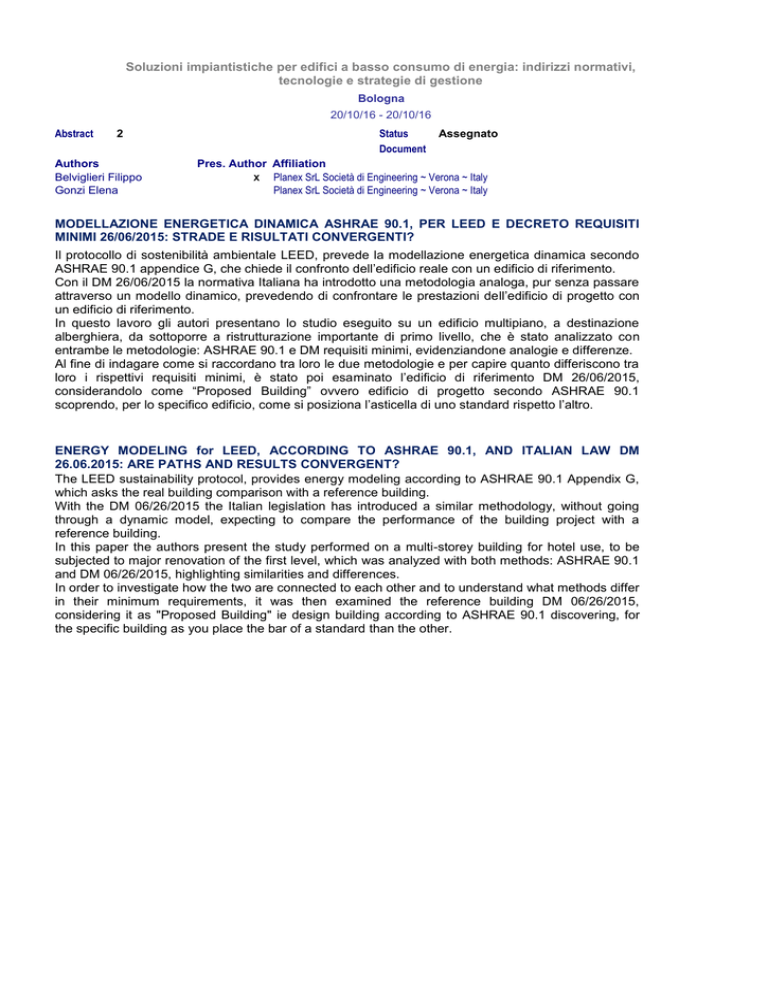
Soluzioni impiantistiche per edifici a basso consumo di energia: indirizzi normativi,
tecnologie e strategie di gestione
Bologna
20/10/16 - 20/10/16
Abstract
2
Authors
Belviglieri Filippo
Gonzi Elena
Status
Document
Assegnato
Pres. Author Affiliation
X
Planex SrL Società di Engineering ~ Verona ~ Italy
Planex SrL Società di Engineering ~ Verona ~ Italy
MODELLAZIONE ENERGETICA DINAMICA ASHRAE 90.1, PER LEED E DECRETO REQUISITI
MINIMI 26/06/2015: STRADE E RISULTATI CONVERGENTI?
Il protocollo di sostenibilità ambientale LEED, prevede la modellazione energetica dinamica secondo
ASHRAE 90.1 appendice G, che chiede il confronto dell’edificio reale con un edificio di riferimento.
Con il DM 26/06/2015 la normativa Italiana ha introdotto una metodologia analoga, pur senza passare
attraverso un modello dinamico, prevedendo di confrontare le prestazioni dell’edificio di progetto con
un edificio di riferimento.
In questo lavoro gli autori presentano lo studio eseguito su un edificio multipiano, a destinazione
alberghiera, da sottoporre a ristrutturazione importante di primo livello, che è stato analizzato con
entrambe le metodologie: ASHRAE 90.1 e DM requisiti minimi, evidenziandone analogie e differenze.
Al fine di indagare come si raccordano tra loro le due metodologie e per capire quanto differiscono tra
loro i rispettivi requisiti minimi, è stato poi esaminato l’edificio di riferimento DM 26/06/2015,
considerandolo come “Proposed Building” ovvero edificio di progetto secondo ASHRAE 90.1
scoprendo, per lo specifico edificio, come si posiziona l’asticella di uno standard rispetto l’altro.
ENERGY MODELING for LEED, ACCORDING TO ASHRAE 90.1, AND ITALIAN LAW DM
26.06.2015: ARE PATHS AND RESULTS CONVERGENT?
The LEED sustainability protocol, provides energy modeling according to ASHRAE 90.1 Appendix G,
which asks the real building comparison with a reference building.
With the DM 06/26/2015 the Italian legislation has introduced a similar methodology, without going
through a dynamic model, expecting to compare the performance of the building project with a
reference building.
In this paper the authors present the study performed on a multi-storey building for hotel use, to be
subjected to major renovation of the first level, which was analyzed with both methods: ASHRAE 90.1
and DM 06/26/2015, highlighting similarities and differences.
In order to investigate how the two are connected to each other and to understand what methods differ
in their minimum requirements, it was then examined the reference building DM 06/26/2015,
considering it as "Proposed Building" ie design building according to ASHRAE 90.1 discovering, for
the specific building as you place the bar of a standard than the other.
Soluzioni impiantistiche per edifici a basso consumo di energia: indirizzi normativi,
tecnologie e strategie di gestione
Bologna
20/10/16 - 20/10/16
Abstract
3
Authors
Maestrelli Stefano
Status
Document
Assegnato
Pres. Author Affiliation
X
azienda usl toscana nordovest ~ pisa ~ Italy
L'ESPERIENZA ECOEFFICIENTE DELL'OSPEDALE "VERSILIA" - TOSCANA
Il caso di studio è quello di un Ospedale Generale con circa 400 posti letto ultimato nel 2002, ma
oggetto di un ulteriore intervento di efficientamento energetico nel 2014.
L'Ospedale “Versilia”, presidio sanitario pubblico della Regione Toscana già nella fase della sua
realizzazione ha inserito una serie di predisposizioni per l'efficienza energetica strutturale ed
impiantistica: L'inserimento ambientale: con riferimento all'orientamento e alla schermatura delle
alberature L'efficienza energetica strutturale: con attenzione all'isolamento dell'involucro edilizio.
L'equilibrata strategia impiantistica: con caldaie a condensazione, cogeneratore ed assorbitore La
regolazione impiantistica: il BMS per il controllo e la conduzione/manutenzione Le fonti energetiche
rinnovabili. Attraverso l'utilizzo e la gestione del cogeneratore a motore endotermico di 1Mwe è stato
possibile produrre direttamente circa il 75% dell'energia elettrica necessaria e attraverso un evoluto
sistema B.M.S. con circa 12.000 punti di analisi e regolazione dell'impiantistica elett. e mecc. è stato
possibile raggiungere l'obiettivo della consistente riduzione dei consumi energetici: dai 4.131 TEP del
2003 ai 2.511 TEP del 2015 (- 39,2%).
Il risultato è stato ottenuto anche attraverso l'installazione nel 2010 di un impianto di produzione
fotovoltaica di 195 Kwe e l'installazione di un secondo cogeneratore a microturbine di 600 Kwe nel
2014, portando l'ospedale ad essere un edificio a “prelievo elettrico zero”.
THE EXPERIENCE OF HOSPITAL ECO-EFFICIENT "VERSILIA" - TUSCANY
The case study is that of a general hospital with about 400 beds completed in 2002, but subject to
further implementing energy efficiency measures in 2014.
The Hospital "Versilia", the public health center of the Region of Tuscany at the stage of its
implementation has added a series of preparations for the structural energy efficiency and plant: The
environmental integration: with reference to guidance and shielding of trees The structural energy
efficiency: with attention to the insulation of the building envelope The balanced strategy plant: with
condensing boilers, CHP and absorber The plant adjustment: the BMS for the control and the driving
/ maintenance
Renewable energy sources Through the use and management of the internal combustion engine
cogenerator 1MWe it was possible to directly produce about 75% of the electricity required and
through an advanced system B.M.S. with approximately 12,000 points of analysis and regulation plant
elec. and mech. it was possible to achieve the goal of consistent reduction of energy consumption:
from 4,131 in 2003 to 2,511 TEP TEP of 2015 (- 39.2%).
The result was obtained even through the installation in 2010 of a photovoltaic plant of production of
195 Kwe and the installation of a second cogenerator microturbines of 600 Kwe in 2014, bringing the
hospital to be a building in "electric zero levy”.
Soluzioni impiantistiche per edifici a basso consumo di energia: indirizzi normativi,
tecnologie e strategie di gestione
Bologna
20/10/16 - 20/10/16
Abstract
4
Authors
Curculacos Giovanni
Turchetto Gianluca
Romagnoni Piercarlo
Status
Document
Assegnato
Pres. Author Affiliation
X
TFE ingegneria srl ~ Pianiga ~ Italy
Gianluca Turchetto libero professionista ~ Spinea ~ Italy
University IUAV of Venezia ~ Venezia ~ Italy
QUALITÀ EDILIZIA E OTTIMIZZAZIONE ENERGETICA PER UNA MIGLIORE SOSTENIBILITÀ E
QUALITÀ DI VITA – DALLA PROGETTAZIONE AL MONITORAGGIO DI UNA NUOVA RSA
Le moderne Residenze Sanitarie Assistenziali costituiscono gli ambienti che più si avvicinano ad una
struttura Sanitaria: offrono a soggetti non totalmente autosufficienti, un medio livello di assistenza
medica, infermieristica e riabilitativa, accompagnata da un alto livello di tutela assistenziale ed
alberghiera: questo richiede un corretto controllo delle condizioni termoigrometriche invernali ed
estive, della qualità illuminotecnica ed acustica.
Inoltre, i tassi di rinnovo dell’aria e gli elevati fabbisogni di acqua calda sanitaria, incidono
significativamente sull’impronta energetica del fabbricato.
Questi elementi sono stati ampiamente affrontati nella RSA realizzata a Noale (VE) dalla Cazzaro
Costruzioni srl. Le soluzioni edilizie ed impiantistiche adottate sono scaturite dalla collaborazione tra
investitore, progettisti ed esecutori, nel rispetto degli obiettivi di investimento, concretizzandosi in
sistemi di isolamento e chiusure trasparenti ad alte prestazioni, apparati di produzione energetica con
fonte rinnovabile, sistemi di distribuzione ad elevata efficienza e recupero, terminali di climatizzazione
peculiari.
L’edificio è stato seguito in fase di costruzione ed è stato sottoposto a monitoraggio dei parametri
microclimatici ed energetici, individuando le aree di maggiore criticità e le strategie di ottimizzazione.
Vengono presentati i risultati di tre anni di esercizio, analizzando i costi di gestione, i monitoraggi
ambientali e i flussi energetici.
QUALITY CONSTRUCTION AND OPTIMIZATION OF ENERGY AND SUSTAINABILITY FOR
BETTER QUALITY OF LIFE - DESIGN COMMISSIONING AD MONITORING OF A NEW ELDERLY
RESIDENCE
The modern nursing homes are close up to a Health structure: they offer to non-totally self-sufficient,
an average level of medical care, nursing and rehabilitation, accompanied by a high level of care and
hospitality: this requires proper inspection temperature and humidity conditions, lighting and sound
quality. Furthermore, the air renewal rates and the high requirements of sanitary hot water,
significantly affect the building energy footprint.
These elements have been widely covered in the RSA realized in Noale (VE) from Cazzaro
Construction Ltd. The building and plant engineering solutions resulted from the collaboration between
investors, designers and performers, in respect of the investment objectives. Have been employed
high-performance insulation systems and transparent enclosures, energy production equipment with
renewable sources, high efficiency distribution systems with energy recovery and peculiar climate
control terminals.
The building has been followed under construction; microclimate and energy parameters has been
monitored, identifying the most critical areas and optimization strategies.
We present the results of three years of service, analyzing the operating costs, environmental
monitoring and energy flows.
Soluzioni impiantistiche per edifici a basso consumo di energia: indirizzi normativi,
tecnologie e strategie di gestione
Bologna
20/10/16 - 20/10/16
Abstract
5
Authors
Khaldi Jilani
Status
Document
Assegnato
Pres. Author Affiliation
X
Facoltà di Architettura di Pescara ~ Pescara ~ Italy
POZZO VINDEX
Il pozzo vindex è una variante del classico pozzo canadese ma è molto più facile da realizzare, più
economica ed efficiente.
Il pozzo vindex è un sistema geotermico passivo che si basa sullo scambio termico tra l'aria ed il
terreno che ad una certa profondità mantiene una temperatura quasi costante tutto l'anno.
Il principio di funzionamento è molto semplice. L'aria esterna è aspirata da un ventilatore centrifugo e
convogliata all’interno di un tubo interrato verticalmente collegato ad una serpentina in rame a contatto
diretto col terreno a 7 m di profondità. Dopo aver attraversato la serpentina, l’aria risale attraverso un
secondo tubo isolato per immettersi all’interno dell’ambiente da climatizzare. Nel 2015 abbiamo
realizzato a Celenza Sul Trigno (CH) il primo pozzo vindex per rinfrescare/riscaldare una sala a forma
di cupola catenaria di 102 m^2 di superficie e di 314 m^3 di volume. La temperatura del terreno a 7 m
di profondità è di circa 15° C tutto l’anno. D’estate l’aria calda che attraversa il pozzo vindex è
raffreddata, mentre quella fredda invernale è riscaldata. Il pozzo vindex a Celenza Sul Trigno è
attualmente in funzione ed i risultati sono molto soddisfacenti, sia in termini economici che ambientali.
VINDEX WELL
The vindex well is a variant of the classic Canadian well but it is much easier to make, cheaper and
more efficient.
The vindex well is a passive geothermal system that is based on heat exchange between the air and
the soil to a certain depth that maintains an almost constant temperature throughout the year.
The principle of operation is very simple. The outside air is sucked by a centrifugal fan and conveyed
inside of a buried pipe connected to a copper coil which is in direct contact with the soil to 7 m deep.
After passing through the coil, the air goes through a second isolated pipe till the environment to be
conditioned. In 2015 we realized in Celenza Sul Trigno (CH) the first well vindex to cool / heat a
dome-shaped space (102 m^2 surface and 314 m^3 volume). The temperature of the soil at 7 m depth
is about 15 ° C all the year. In summer the hot air flowing through the vindex well is cooled, while in
winter it is heated.
The vindex well in Celenza Sul Trigno is currently is up and running and the results are very
satisfactory, both in economic and environmental terms.
Soluzioni impiantistiche per edifici a basso consumo di energia: indirizzi normativi,
tecnologie e strategie di gestione
Bologna
20/10/16 - 20/10/16
Abstract
6
Authors
Fusco Dario
Chiaroni Davide
Marengo Marco
Status
Document
Assegnato
Pres. Author Affiliation
X
Strutture & Energia ~ Bergamo ~ Italy
Politecnico di Milano ~ Milano ~ Italy
University of Brighton ~ Brighton ~ United Kingdom
IL RUOLO DELLE ESCO E DEL NUOVO CONTO TERMICO NELLA DIFFUSIONE DEGLI NZEB
NELLE
PUBBLICHE
AMMINISTRAZIONI:
ANALISI
TECNICO-FINANZIARIA
DELLA
RIQUALIFICAZIONE DI UN MUNICIPIO NELLA BERGAMASCA.
Gli nZEB presentano indubbi vantaggi dal punto di vista energetico ed ambientale. Per contro, a
causa dei significativi costi di realizzazione, non ne è altrettanto chiara la convenienza economica.
In Lombardia l’entrata in vigore della normativa nZEB di fatto coincide con l’introduzione del Nuovo
Conto Termico che, consentendo di ottenere contributi a fondo perduto fino al 65%, intende
incentivare la diffusione di questo tipo di intervento.
Il presente articolo si propone quindi di valutare innanzitutto l’incremento di costo che comporta
riqualificare un tipico edificio pubblico per elevare la classe energetica dagli attuali requisiti di legge a
quelli imposti dalla nuova normativa nZEB, con il relativo impatto del Nuovo Conto Termico.
Quindi analizzare la convenienza economica per l’ente pubblico nei due alternativi casi di:
investimento diretto totalmente sostenuto dall’ente stesso o intervento effettuato per il tramite di una
ESCO.
Lo studio si conclude con una valutazione comparativa sulla convenienza di un rapporto Ente- ESCO
basato su di un “contratto a risparmi condivisi” ovvero su di un “contratto a servizio energia”.
A tal scopo viene analizzato il caso reale della riqualificazione di un tipico edificio pubblico di medie
dimensioni (circa 2'300 mq/6'000 mc), sede del Municipio di un paese di 10'000 abitanti nella provincia
bergamasca, i cui lavori appaltati comprendono il rifacimento del tetto, l’applicazione del cappotto e la
sostituzione dell’impianto climatico.
THE ROLE OF ESCOS AND NEW THERMAL ACCOUNT IN THE DIFFUSION OF NZEBS IN
PUBLIC BUILDINGS: TECHNICAL AND FINANCIAL ANALYSIS OF THE REQUALIFICATION OF
A TOWN HALL IN THE PROVINCE OF BERGAMO
NZEBs have undoubted advantages from an energetic and environmental point of view. Nonetheless,
because of the significant investments required, economic profitability is not so evident. In Lombardy,
the new legislation about NZEB is applied in conjunction with the New Thermal Account that,
supporting investments with grants up to 65%, aims to encourage the diffusion of this type of
intervention. The goal of this article is firstly to assess the increase in cost resulting from improving the
energy class of a typical public building from the current legal requirements, to those imposed by the
new NZEB legislation, while taking into account the economic impact of the New Thermal Account.
The second goal aims to analyze the cost-effectiveness of the project considering an investment fully
supported by the Public Authority or, alternatively, supported by an ESCO. The study ends with a
comparative assessment between a "shared savings contract" and on a "energy service contract"
regulating the relationship between ESCOs and the Public authority. For this purpose, the real case of
the requalification of a typical medium size public building (about 2,300 square meters / 6,000 cubic
meters) has been analyzed, that is the town hall of a village of 10,000 citiziens in the province of
Bergamo: the contracted project includes the reconstruction of the roof, the application of the thermal
coat and the replacement of the climatic system.
Soluzioni impiantistiche per edifici a basso consumo di energia: indirizzi normativi,
tecnologie e strategie di gestione
Bologna
20/10/16 - 20/10/16
Abstract
7
Authors
Dongellini Matteo
Abbenante Massimiliano
Morini Gian Luca
Status
Document
Assegnato
Pres. Author Affiliation
X
Alma Mater Studiorum - Università di Bologna ~ Bologna ~ Italy
Alma Mater Studiorum - Università di Bologna ~ Bologna ~ Italy
Alma Mater Studiorum - Università di Bologna ~ Bologna ~ Italy
INFLUENZA DEI SISTEMI DI REGOLAZIONE E GENERAZIONE DELL'IMPIANTO
RISCALDAMENTO SULLE CONDIZIONI DI COMFORT INTERNO DI AULE SCOLASTICHE
DI
In questo lavoro viene presentata un’analisi dell’influenza di diverse tipologie di generatori di calore e
di sistemi di regolazione sulle condizioni di comfort termo-igrometrico interno alle aule scolastiche
dell’Istituto G. Marconi di Castelfranco Emilia. L’Istituto è attualmente riscaldato da due caldaie a
condensazione accoppiate a radiatori ad alta temperatura mentre il sistema di regolazione è basato
sulla compensazione climatica e sull’intervento di un cronotermostato in funzione del periodo di
occupazione dell’edificio.
Attraverso il software TRNSYS è stato simulato il comportamento dell’impianto di riscaldamento
esistente, valutando le sue prestazioni energetiche e le condizioni di comfort garantite dall’impianto
nelle varie aule. Il calcolo è stato poi ripetuto andando a sostituire le caldaie esistenti con pompe di
calore aria-acqua multi-compressore, accoppiate a terminali a bassa temperatura. La regolazione del
sistema viene effettuata in questo caso in base alla misura delle temperature di mandata e ritorno
dell’acqua dell’impianto senza l’ausilio di una sonda di temperatura esterna.
I risultati ottenuti mettono in evidenza come la mancanza di un termostato di zona non permetta il
controllo della temperatura interna: le aule esposte ad Ovest sono caratterizzate da valori di
temperatura interna inferiori rispetto a quelli che si hanno nelle aule rivolte a Sud e ad Est. Le
condizioni di comfort interno tendono infine a variare molto durante la stagione invernale.
INFLUENCE OF CONTROL STRATEGY AND HEAT GENERATING SYSTEM ON
THERMO-HYGROMETRIC COMFORT CONDITIONS WITHIN SCHOOL CLASSROOMS
This paper presents an analysis of the influence of different types of heat generator and control
strategy on thermo-hygrometric comfort conditions, occurring within the classrooms of the school
building Istituto G. Marconi, located in Castelfranco Emilia. The school is currently heated by two
condensing boilers coupled to high temperature radiators, while the system control strategy is based
on climatic compensation and the intervention of a programmable thermostat, which refers to the
occupancy period of the building.
First, the behavior of actual heating system was simulated by means of the dynamic software
TRNSYS, assessing the energy performance of the building and the comfort conditions guaranteed by
the heating system within classrooms. The calculation was then performed by replacing the existing
boilers with a multi-compressor air-to-water heat pump, coupled to low temperature terminals. The
system control strategy is carried out in this case according to the measure of supply and return water
temperatures to the heat pump, without the measure of external air temperature.
Results highlight how the lack of thermostats within the school does not allow a precise control of the
internal temperature: classrooms exposed to West are characterized by internal temperature values
much lower than the ones obtained for classrooms facing South and East. Finally, the internal comfort
conditions are characterized by a high variability during the winter season.
Soluzioni impiantistiche per edifici a basso consumo di energia: indirizzi normativi,
tecnologie e strategie di gestione
Bologna
20/10/16 - 20/10/16
Abstract
8
Authors
De Antonellis Stefano
Joppolo Cesare Maria
Liberati Paolo
Status
Document
Assegnato
Pres. Author Affiliation
X
Politecnico di Milano ~ Milano ~ Italy
Politecnico di Milano ~ Milano ~ Italy
Recuperator S.p.A. ~ Rescaldina ~ Italy
ANALISI SPERIMENTALE DELLE PRESTAZIONI DI UN SISTEMA DI RAFFREDDAMENTO
EVAPORATIVO INDIRETTO
Indirect evaporative cooling (IEC) is an effective way to increase energy efficiency of air conditioning
systems. At present, there are many ongoing research activities about IEC systems, mainly dealing
with new heat exchanger materials and geometries, new humidification systems or evaluating potential
primary energy savings compared to conventional devices. In this work an indirect evaporative cooling
system based on a cross flow heat exchanger has been widely tested, in order to evaluate the effect of
different system setup on performance. In particular, three different water nozzles positions have been
analyzed: installation respectively on the top, on the side and on the bottom of the heat exchanger.
Tests have been performed in typical operating conditions of data centers, where the indoor
temperature is generally higher than in residential and commercial buildings and, as a consequence,
energy savings are significant. Results put in evidence that best and worst performance is achieved
respectively when water is supplied from the top and from the bottom of the system.
EXPERIMENTAL ANALYSIS OF PERFORMANCE OF AN INDIRECT EVAPORATIVE COOLER
Il raffreddamento evaporativo indiretto è un metodo molto efficace per incrementare l'efficienza dei
sistemi di climatizzazione. Al momento sono in corso molte attività di ricerca in merito allo sviluppo di
tali sistemi, in particolare riguardo nuovi materiali e geometrie dello scambiatore, nuovi sistemi di
umidificazione e ai potenziali risparmi di energia rispetto ai sistemi tradizionali di climatizzazione. Nel
presente lavoro un sistema di raffrescamento evaporativo indiretto, basato su uno scambiatore a flussi
incrociati, è stato ampiamente testato, in modo da valutare l'effetto della posizione degli ugelli sulle
prestazioni. Più precisamente sono state analizzate tre diverse configurazioni: ugelli posti nella
sezione superiore, laterale e inferiore dello scambiatore. I test sono stati eseguiti in tipiche condizioni
di funzionamento di data center, in cui la temperatura ambiente è generalmente maggiore di quella
adottata in edifici residenziali e commerciali e, di conseguenza, possono essere ottenuti risparmi
significativi di energia primaria. I risultati mettono in evidenza che le prestazioni migliori si ottengono
con umidificazione dall'alto, mentre quelle peggiori con umidificazione dal basso.
Soluzioni impiantistiche per edifici a basso consumo di energia: indirizzi normativi,
tecnologie e strategie di gestione
Bologna
20/10/16 - 20/10/16
Abstract
10
Authors
Schibuola Luigi
Status
Document
Assegnato
Pres. Author Affiliation
X
Università IUAV di Venezia ~ Venezia ~ Italy
GEOTERMIA IN AREA UMIDA: UNA VALUTAZIONE SPERIMENTALE
Questa memoria illustra i risultati di una campagna di monitoraggio su una pompa di calore abbinata a
sonde geotermiche verticali installata nel centro storico di Venezia nel quadro della ristrutturazione di
un antico palazzo dove altri fonti di energia rinnovabile, come l'energia solare, non sono ammesse a
causa delle norme di tutela monumentale. Nonostante la posizione costiera, l'uso di acque superficiali
o terreno non era possibile in questo caso.
Infatti, il prelievo da pozzi è assolutamente vietato a Venezia, a causa del rischio di cedimento del
terreno. Inoltre, come spesso accade a Venezia, i canali interni accanto all'edificio hanno portata
d'acqua insufficiente. L'analisi sperimentale evidenzia prestazioni molto soddisfacenti soprattutto in
confronto con l'uso alternativo di pompe di calore con sorgente aria. L'alta umidità del terreno e la
portata d'acqua sotterranea presente anche negli strati superficiali del terreno risulta promuovere un
rapido riequilibrio termico nell'intorno delle sonde. Per lo stesso motivo, nonostante lo squilibrio tra il
calore dissipato in estate e quello estratto durante l'inverno, non è stata rilevata nel tempo alcuna
conseguente degradazione termica per lo scambio con il terreno.
GEOTHERMAL ENERGY IN HIGH HUMIDITY AREAS: AN EXPERIMENTAL ASSESSMENT
This paper shows the results of a monitoring campaign on a invertible ground source heat pump
(GSHP) with borehole heat exchangers installed in the historical center of Venice in the frame of the
renovation of an ancient building where other renewable energy systems, such as solar energy
systems, are not admitted because of historical preservation regulations. Despite the coastal position,
the use of surface or ground water was not achievable in this case. In fact, the withdrawal from wells is
absolutely forbidden in Venice, due to the risk of subsidence of the soil. In addition, as often happens
in Venice, the internal channels next to the building have insufficient water flow rate. The experimental
analysis highlights very satisfactory performance especially in comparison with the alternative use of
air source heat pumps. The high humidity of the soil and the underground water flow present even in
the surface layers of the soil promote the quick thermal rebalancing in the borehole field. For the same
reason, although the unbalance between the heat rejected in summer and the one extracted during
winter, no consequent thermal degradation of the ground heat exchange is encountered.
Soluzioni impiantistiche per edifici a basso consumo di energia: indirizzi normativi,
tecnologie e strategie di gestione
Bologna
20/10/16 - 20/10/16
Abstract
11
Authors
Corgnati Stefano Paolo
Vio Michele
Babuin Michele
Ranieri Micaela
Status
Document
Assegnato
Pres. Author Affiliation
Politecnico di Torino ~ Torino ~ Italy
X
Consulente Rhoss – Gruppo IRSAP ~ Venezia ~ Italy
Rhoss – Gruppo IRSAP ~ Codroipo ~ Italy
Rhoss – Gruppo IRSAP ~ Codroipo ~ Italy
CONFRONTO TRA IMPIANTI A TUTT'ARIA VAV E AD ARIA PRIMARIA: L'IMPORTANZA DEL
CONSUMO DEGLI AUSILIARI
La progettazione dell’impianto per la climatizzazione negli edifici nZEB richiede particolare attenzione
nella valutazione delle reali prestazioni energetiche.
Un adeguato livello di isolamento termico è imprescindibile per la riduzione dei consumi e consente di
sfruttare maggiormente il free-cooling, non solo estivo, limitando di conseguenza il peso del consumo
energetico dei generatori.
In questo scenario assume primaria importanza la valutazione ed il contenimento del consumo degli
ausiliari.
Gli impianti a tutta aria VAV possono sfruttare molto bene il free-cooling, ottenendo ottime prestazioni,
a patto di contenere le perdite di carico lato aria minimizzano così i consumi di ventilazione.
Gli impianti ad aria primaria, al contrario, sfruttano meno il free cooling, ma riducono sensibilmente
l’energia richiesta per gli ausiliari spostando di conseguenza l’attenzione sull’efficienza dei generatori.
La memoria propone i risultati di un’ampia ricerca che confronta in modo analitico 3 tipologie di
impianto in 5 tipologie di edificio per uffici collocato in 9 differenti città nel mondo:
- Impianto ad aria primaria con fan-coil
- Impianto ad aria primaria con soffitto radiante
- Impianto a tutt’aria VAV
FULL-AIR VAV SYSTEMS COMPARED TO FRESH-AIR SYSTEMS: IMPORTANCE OF AUXILIARY
LOADS CONSUMPTION
The HVAC systems design in nearly-Zero Energy Buildings requires particular attention in the
evaluation of actual energy performance.
An appropriate level of thermal insulation is essential to reduce building consumption and allows a
great use of free-cooling, not only summertime, thereby limiting the energy consumption of generators.
In these systems it takes primary importance the evaluation and the reduction of auxiliary
consumption.
Full-air VAV systems can greatly use the free-cooling, getting good performance, as long to minimize
air side pressure losses and the ventilation consumption.
Fresh-air systems, as opposed, get less advantage from free-cooling, but significantly reduce the
energy consumption for auxiliary loads shifting the focus on the generators efficiency.
The paper offers the results of a wide research that analytically compares 3 types of systems in 5
types of office building located in 9 different cities around the world:
- Fresh-air system with fan-coils
- Fresh-air system with radiant ceiling
- Full-air system VAV
Soluzioni impiantistiche per edifici a basso consumo di energia: indirizzi normativi,
tecnologie e strategie di gestione
Bologna
20/10/16 - 20/10/16
Abstract
12
Authors
Campana Jean Pierre
Morini Gian Luca
Status
Document
Assegnato
Pres. Author Affiliation
X
Alma Mater Studiorum ~ Bologna ~ Italy
Alma Mater Studiorum ~ Bologna ~ Italy
EFFETTO DEI REQUISITI MINIMI SUI FABBISOGNI ENERGETICI ESTIVI ED INVERNALI.
L’introduzione della nuova legislazione sui requisiti minimi delle nuove costruzioni, impone importanti
cambiamenti sia nella progettazione degli impianti tecnici che degli involucri edilizi. La necessità di
soddisfare la verifica di legge sul coefficiente medio globale di scambio termico impone la
realizzazione di edifici sempre più isolati. Il metodo dell’edificio di riferimento permette di confrontare i
consumi di energia primaria dell’edificio reale con quelli dello stesso edificio nel caso in cui vengano
rispettati tutti i requisiti minimi di legge. L’isolamento termico previsto per l’edificio di riferimento
utilizzato per la verifica dei requisiti minimi aumenterà nel 2019-2021 ma non cambierà il livello di
schermaggio dei componenti trasparenti di involucro.
Ciò può portare ad un peggioramento delle prestazioni estive passando dall'edificio di riferimento
attuale a quello futuro.Infatti il carico termico estivo è principalmente dovuto all'irraggiamento solare e
non allo scambio di calore attraverso le pareti esterne, che in estate può diventare un utile strumento
per ridurre il carico termico entrante. Tutto ciò non è in linea con lo spirito della legge che vorrebbe
guidare verso edifici sempre meno energivori. In questo studio, attraverso una serie di simulazioni
numeriche, verrà dimostrato come sarà più facile per un edificio nuovo rispettare i requisiti minimi
previsti in futuro rispetto a quelli attuali nel caso del servizio energetico di condizionamento estivo.
EFFECT OF THE LAW ON MINIMUM REQUIREMENTS ON WINTER AND SUMMER ENERGY
NEEDS
The introduction of the new legislation on minimum requirements for new buildings, imposes relevant
changes in the design of thermal plant and of building envelope. The need to satisfy the minimum
requirement on mean global heat transfer coefficient leads to more and more insulated buildings.
The reference building method is used to compare the primary energy needs of the actual building
with those of the same building in case of minimum requirements satisfaction. By the 2019-2021, the
level of thermal insulation expected for the reference building used for the verification of minimum
requirements will increase. On the other hand, the level of shading of transparent components will not
change. So, using new reference building instead of the actual ones could lead to lower summer
performances.
In fact, summer thermal load is mainly due to solar radiation, instead of heat exchange through
external walls, which in summer can be used to reduce incoming thermal load.
This doesn’t agree with the aim of the law, which consists in helping designers to make new buildings,
characterized by lower primary energy needs.
In the present work, by means of several numerical simulations, it will be shown that, for a new
building, it will be easier to satisfy future minimum requirements for the energy service of the summer
air conditioning than the actual ones.
Soluzioni impiantistiche per edifici a basso consumo di energia: indirizzi normativi,
tecnologie e strategie di gestione
Bologna
20/10/16 - 20/10/16
Abstract
13
Authors
Lucchi Elena
Tabak Magdalena
Carì Valentina
Status
Document
Assegnato
Pres. Author Affiliation
EURAC Research ~ Bolzano ~ Italy
EURAC Research ~ Bolzano ~ Italy
X
Studio Carì ~ Bellano ~ Italy
BIPV ED EDIFICI STORICI: UN’INTEGRAZIONE È POSSIBILE?
L’integrazione dei pannelli fotovoltaici su edifici storici è un tema molto dibattuto. Se da un lato, la
legislazione nazionale richiede un aumento progressivo dell’uso energia prodotti da fonti rinnovabili,
dall’altro permane ancora una serie di difficoltà legate alla loro accettazione estetica sugli edifici
storici. Il lavoro presenterà i risultati di una corretta integrazione paesaggistica e architettonica
(building integrate photovoltaics - BiPV) di un sistema di pannelli in silicio amorfo su una villa
ottocentesca ubicata sul Lago di Como. Dopo avere descritto le particolarità del progetto impiantistico,
saranno analizzati i dati di produzione che sono monitorati in loco da un sistema ICT appositamente
realizzato per ottimizzarne le prestazioni impiantistiche e le strategie di gestione. Infine, sarà
analizzato il rapporto tra i consumi elettrici effettivi e la produzione energetica dell’impianto
fotovoltaico.
BIPV AND HISTORIC BUILDINGS: A POSSIBLE INTEGRATION?
The integration of PV panels on historic buildings is a debated topic. On the one hand, the national
legislation requires a progressive increasing of the use of renewable energy sources; on the other
hand, several difficulties related to their aesthetics acceptance in historical buildings remain unsolved.
The work presents the results of a proper landscape and architectural integration (building integrate
photovoltaics - BiPV) of amorphous silicon panels on a villa located on Como Lake. After describing
the plant details of project, the production data monitored on-site by an ICT system specifically
designed to optimize plant performance and management strategies has been analyzed. Finally, the
work examines also the relationship between the actual power consumption and the energy
production of the PV system.
Soluzioni impiantistiche per edifici a basso consumo di energia: indirizzi normativi,
tecnologie e strategie di gestione
Bologna
20/10/16 - 20/10/16
Abstract
14
Authors
Zattoni Roberto
Status
Document
Assegnato
Pres. Author Affiliation
X
Flakt Woods Spa ~ Muggiò ~ Italy
SOLUZIONI VAV/DCV PER IMPIANTI A TRAVI FREDDE
Elevate condizioni di comfort negli ambienti, unite a un’ottimizzazione dei costi di esercizio degli
impianti, hanno portato a una notevole diffusione, in particolare nei Paesi del centro e nord Europa, di
soluzioni VAV/DCV. Lo stesso fenomeno non ha ancora avuto la stessa rilevanza in Italia.
Noti i vantaggi degli impianti a travi fredde rispetto ai tradizionali sistemi a fancoil e a tutt’aria, nella
relazione si evidenzia come questi vantaggi possano crescere ulteriormente grazie all’utilizzo di nuove
tecnologie che trasformano le travi fredde in sistemi VAV, con effetti positivi in termini di risparmio
energetico. I miglioramenti energetici sono legati sia alla ottimizzazione della portata di ventilazione in
funzione del livello di affollamento nell’ambiente, sia alla resa frigorifera prodotta dalla trave fredda.
La standardizzazione e la maggiore semplificazione, conseguente al minor numero di componenti in
gioco, dei sistemi a travi fredde influisce positivamente anche sui costi di realizzazione dell’impianto.
VAV/DVC SYSTEMS WITH CHILLED BEAMS
Last years have seen a growing diffusion, particularly in Center and North Europe, of ventilation
systems using VAV and DCV as the best solution to drive high levels of Indoor Air Quality and, at the
same time, optimization of running costs. A similar trend has not yet seen in Italy.
The advantages of chilled beams versus traditional systems with fan coils or full air are well known;
the paper highlights how these benefits can be further increased using new technologies that
transform chilled beams into VAV systems, with positive effects in terms of energy saving. The energy
improvements are linked both to the optimization of the ventilation depending from the actual
occupancy in the room, and to the cooling capacity produced by the chilled beam.
The standardization and simplification of chilled beam systems, due to the smaller number of
components involved, have also positive effect on investment costs.
Soluzioni impiantistiche per edifici a basso consumo di energia: indirizzi normativi,
tecnologie e strategie di gestione
Bologna
20/10/2016 - 20/10/2016
Abstract
15
Authors
Ghisleni Massimo
Status
Document
Assegnato
Pres. Author Affiliation
X
Robur SpA ~ Verdellino (BG) ~ Italy
SISTEMI DI MONITORAGGIO E GESTIONE REMOTA DI UNITA’ IN POMPA DI CALOREAD
ASSORBIMENTO
L’efficienza di un sottosistema di generazione non è mai determinato unicamente dall’efficienza dei
generatori installati, per quanto questi possano essere caratterizzati da elevate efficienze di utilizzo dei
vettori energetici. Le logiche di regolazione, la presenza e l’uso dei vari componenti della centrale
termica, le abitudini degli utenti e dei gestori dell’impianto, sono tra i fattori cruciali che determinano il
pieno raggiungimento degli obiettivi energetici definiti in fase di progettazione. Nella presente memoria
si metterà in luce come opportuni sistemi di monitoraggio e gestione remota dei sottosistemi siano
trumenti fondamentali, per consentire a qualsiasi tecnologia di generazione di poter esprimere la
massima efficienza possibile. In particolare ci si concentrerà sui sottosistemi di generazione costituiti
da pompe di calore ad assorbimento.
REMOTE MONITORING AND MANAGEMENT OF GAS ABSORPTION HEAT PUMPS
The global efficiency of a heating plant is not only determined by the efficiency of the installed thermal
power generators, even if they are very effective in using energy.
The expected level of efficiency and performance are also due to the adjustments setup, the kind of
installed components and to the users’ habits.
In this document will be described the high impact of the remote monitoring and management in order
to achieve the highest possible efficiency. There will be a specific focus on the Gas Absorption Heat
Pumps technology.
Soluzioni impiantistiche per edifici a basso consumo di energia: indirizzi normativi,
tecnologie e strategie di gestione
Bologna
20/10/2016 - 20/10/2016
Abstract
Status
16
[1]
[1]
Elena Bee* , Alessandro Prada , Paolo Baggio
[1]
Assegnato
[1]
Università degli Studi di Trento ~ Trento ~ Italy
VALUTAZIONE DEL COP STAGIONALE DELLE POMPE DI CALORE ARIA-ACQUA CON
INVERTER IN DIVERSI CLIMI ITALIANI.
Considerati gli attuali orientamenti legislativi (Decreto legislativo 28/2011) che richiedono di soddisfare
una crescente quota dei fabbisogni di energia per la climatizzazione con fonti rinnovabili, le pompe di
calore aerotermiche appaiono particolarmente promettenti, in particolare quelle di ultima generazione
con portata variabile di fluido refrigerante grazie al compressore controllato da inverter. Tuttavia, il
dimensionamento della pompa di calore e la valutazione delle prestazioni stagionali della stessa sono
più complessi rispetto ai sistemi di generazione più comunemente impiegati (caldaia), essendo
fortemente influenzati dal clima di riferimento e dall’andamento del carico termico di climatizzazione
dell’edificio. Uno degli strumenti attualmente a disposizione dei progettisti è la procedura di calcolo
nota come metodo “bin”, richiesto dalla UNI TS 11300-4, in cui i “bin” sono basati su una distribuzione
normale mensile di temperatura costruita su dati medi mensili. Questa distribuzione è diversa da
quella ottenibile dall’anno tipo della stessa località fornito dal CTI, e tale differenza si ripercuote sulla
valutazione della prestazione stagionale delle pompe di calore. I due input climatici vengono pertanto
confrontati, nei diversi climi italiani, in termini di prestazioni stagionali, relative a diversi modelli di
pompa di calore a inverter, e di percentuale di copertura dei carichi, considerando anche il
funzionamento a carico parziale.
EVALUATION OF THE SEASONAL COP OF AIR-TO-WATER HEAT PUMPS WITH
INVERTER IN DIFFERENT ITALIAN CLIMATES
Considering the current legislative tendency (Italian Decree 28/2011) that require to cover a significant
part of the energy needs for air conditioning with renewable sources, air-source heat pumps seem to
be a particularly promising technology, especially the latest generation units with a variable flow of
refrigerant fluid through the compressor controlled by an inverter. However, the dimensioning of the
heat pump and the evaluation of the seasonal performance are more complex than the commonly
installed heating systems (boiler), and are strongly influenced by the reference climate and by the
building load. One of the tools currently available to designers is the calculation procedure known as
"bin method”, required by the Italian standard UNI TS 11300-4, where the "bins" are based on a
normal temperature distribution built with monthly average data. That frequency distribution is different
from the one obtained with the test reference year of the same location, provided by the CTI, and the
difference has an impact on the evaluation of the seasonal performance of heat pumps. The two
climatic inputs are therefore compared in Italian climates, in terms of seasonal performance (for
different commercial models of inverter-driven heat pump) and in terms of covering fraction, also
considering the operation at partial load.

